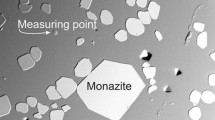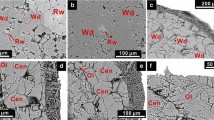Abstract
The behaviour of niobium and tantalum in magmatic processes has been investigated by conducting MnNb2O6 and MnTa2O6 solubility experiments in nominally dry to water-saturated peralkaline (aluminium saturation index, A.S.I. 0.64) to peraluminous (A.S.I. 1.22) granitic melts at 800 to 1035 °C and 800 to 5000 bars. The attainment of equilibrium is demonstrated by the concurrence of the solubility products from dissolution, crystallization, Mn-doped and Nb- or Ta-doped experiments at the same pressure and temperature. The solubility products of MnNb2O6 (Ksp Nb) and MnTa2O6 (Ksp Ta) at 800 °C and 2 kbar both increase dramatically with alkali contents in water-saturated peralkaline melts. They range from 1.2 × 10−4 and 2.6 × 10−4 mol2/kg2, respectively, in subaluminous melt (A.S.I. 1.02) to 202 × 10−4 and 255 × 10−4 mol2/kg2, respectively, in peralkaline melt (A.S.I. 0.64). This increase from the subaluminous composition can be explained by five non-bridging oxygens being required for each excess atom of Nb5+ or Ta5+ that is dissolved into the melt. The Ksp Nb and Ksp Ta also increase weakly with Al content in peraluminous melts, ranging up to 1.7 × 10−4 and 4.6 × 10−4 mol2/kg2, respectively, in the A.S.I. 1.22 composition. Columbite-tantalite solubilities in subaluminous and peraluminous melts (A.S.I. 1.02 and 1.22) are strongly temperature dependent, increasing by a factor of 10 to 20 from 800 to 1035 °C. By contrast columbite-tantalite solubility in the peralkaline composition (A.S.I. 0.64) is only weakly temperature dependent, increasing by a factor of less than 3 over the same temperature range. Similarly, Ksp Nb and Ksp Ta increase by more than two orders of magnitude with the first 3 wt% H2O added to the A.S.I. 1.02 and 1.22 compositions, whereas there is no detectable change in solubility for the A.S.I. 0.64 composition over the same range of water contents. Solubilities are only slightly dependent on pressure over the range 800 to 5000 bars. The data for water-saturated sub- and peraluminous granites have been extrapolated to 600 °C, conditions at which pegmatites and highly evolved granites may crystallize. Using a melt concentration of 0.05 wt% MnO, 70 to 100 ppm Nb or 500 to 1400 ppm Ta are required for manganocolumbite and manganotantalite saturation, respectively. The solubility data are also used to model the fractionation of Nb and Ta between rutile and silicate melts. Predicted rutile/melt partition coefficients increase by about two orders of magnitude from peralkaline to peraluminous granitic compositions. It is demonstrated that the γNb2O5/γTa2O5 activity coefficient ratio in the melt phase depends on melt composition. This ratio is estimated to decrease by a factor of 4 to 5 from andesitic to peraluminous granitic melt compositions. Accordingly, all the relevant accessory phases in subaluminous to peraluminous granites are predicted to incorporate Nb preferentially over Ta. This explains the enrichment of Ta over Nb observed in highly fractionated granitic rocks, and in the continental crust in general.
Similar content being viewed by others
Author information
Authors and Affiliations
Additional information
Received: 9 August 1996 / Accepted: 26 February 1997
Rights and permissions
About this article
Cite this article
Linnen, R., Keppler, H. Columbite solubility in granitic melts: consequences for the enrichment and fractionation of Nb and Ta in the Earth's crust. Contrib Mineral Petrol 128, 213–227 (1997). https://doi.org/10.1007/s004100050304
Issue Date:
DOI: https://doi.org/10.1007/s004100050304




